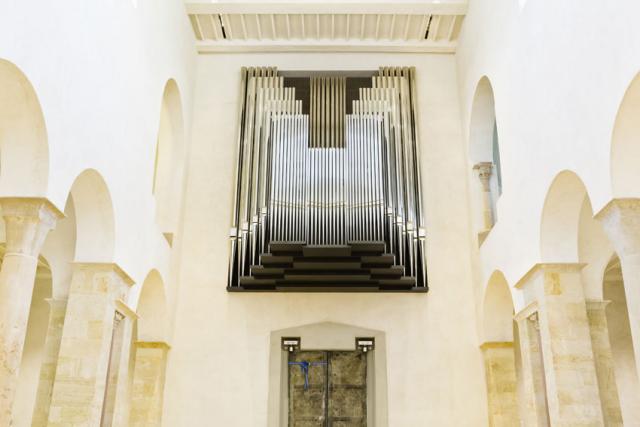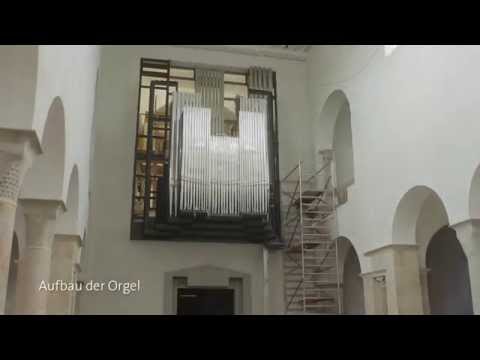The Cathedral organ
Singing by the congregation and choir music form a central part of the Catholic liturgy. In addition to unaccompanied (a cappella) singing, it was conventional from the outset to accompany the hymns of the faithful with instrumental music.
Over the centuries, the pipe organ thus became the most important instrumental accompaniment in Europe. It is, therefore, not surprising that the organ also plays an important role in the renovated Cathedral – not only because it is by far the largest piece of equipment in the Cathedral (the organ weighs over 20 tonnes and the main organ alone is the size of a small house), but also because it is, quite simply, “the” instrument for musical accompaniment in Catholic churches.
History of origins
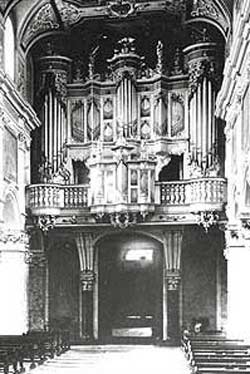
The Cathedral organ prior to 1945. As early as the 14th Century there are written references to at least two organs in Hildesheim Cathedral: the main organ and the small organ. At the start of the 20th century, these organs were reconstructed or renovated, in accordance with the prevailing fashions of the time, by eminent organ builders such as Matthias Naumann from Hildesheim (a fellow Master Organ Builder of Arp Schnitger) in Baroque, and Furtwängler & Hammer from Hannover.
After the Second World War, the Cathedral retained only one organ section in the newly constructed west gallery. This organ was built by Franz Breil from Dorsten in 1960 and was the first Catholic cathedral organ in Germany to operate using a fully mechanical action. The Hanoverian architect Heinz Wolff designed the façade, while the neo-baroque arrangement was put together by Rudolf Reuter from Münster. In 1989, on the initiative of the then Cathedral organist Fritz Soddemann, the Bonn-based Klais workshop carried out a full technical reconstruction of this organ behind the old façade and extended the arrangement to include a swell box. The organ then remained like this until 2010.
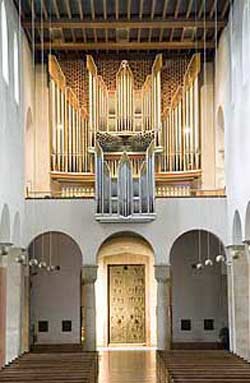
The Cathedral organ in 2007. The decision by the Hildesheim Cathedral chapter to allow the old organ loft to be demolished as part of the renovation works meant that the Cathedral choirs were now given another place in which to sing, which would also need to include space for a choir organ to accompany them. The main organ remained in its previous location, albeit positioned slightly further back and without a projecting choir loft in front of it. Both organs were ordered from the Seifert workshop in Kevelaer, and designed and planned in consultation with the organ builder commissioned from the Cologne-based Schilling architectural firm.
The current arrangement of both organs was designed by the Cathedral musicians. While the choir organ has been completely newly built, many of the parts of the main organ have been reused by Breil and Klais, including 58 stops, almost all the old windchests, and the chassis of the main console. The choir organ offers the whole spectrum of acoustic timbres, providing a sustainable, romantic choral accompaniment; the acoustic concept underlying the main organ is based on that of the Klais organ, though its principal tones, bass stop and solo tones have been renovated and augmented. The acoustic colours in the choir organ’s swell box can also be operated in conjunction with the main organ as a variety of antiphonal. The organ system as a whole can be played using two identical 4-handed consoles. These include the main console above, with its mechanical action, and the general console in the nave, which is fully electric. It is controlled via a BUS system.
Acoustic concept behind the Cathedral organ
The acoustic concept behind the Hildesheim Cathedral organ is based around three central elements:
- The appropriate acoustic timbres must be available in order to interpret organ music from a variety of epochs authentically.
- A large part of the old main organ should be incorporated into the design.
- An additional organ for accompanying the choirs should be located near to the new choir stalls in the nave, the old choir loft being removed as part of the renovation works.
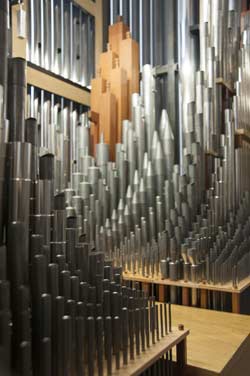
Prior to the renovation of the Cathedral, a careful examination of all the parts of the old main organ showed that it would be neither possible nor necessary to either reconstruct the original without any alterations (given the altered space requirements following the demolition of the choir loft), or to build a totally new organ. Around 80 percent of the organ from 1960/89 was of such high quality that it seemed sensible to reuse it in a “new” main organ. By reusing 58 stops – which is more than 3,200 pipes of varying sizes – the windchests, and the chassis from the old console, the costs could be kept much lower, compared to the cost of building a completely new instrument. When putting together the new arrangement of the main organ with its 77 stops, “stylistic versatility” was the watchword. It is, therefore, not surprising that the arrangement design that has now been implemented is almost identical to the concept envisaged by the earlier cathedral organist Fritz Soddemann in 1988. If we compare the arrangement of the main organ of 1989 with the current one, we can note the following differences:
The bass stop of the organ has been much enhanced in order to give it sufficient power when playing in a full church, or for playing organ works from the Romantic period. In addition, stops have been moved to the area of the pedal.
The character and operation of the individual manual sections have been more clearly defined by offsetting and replacing tones. Thus, for example, the rear positive has been upgraded as a counterpart to the main organ and some typically romantic timbres in the swell box have been augmented, timbres that also have a particularly mystical tonal component.
The prominent Spanish trumpets that were previously tonally strong have been retained, moved to the interior of the organ and supplemented with a romantic-sounding high pressure section. This also makes it possible to reproduce organ music from England and America from the 19th and 20th centuries, for instance, with stylistic accuracy. The tonal basis has been given greater versatility by extending the octave coupling.
 In order to be able to design the acoustics for the choir organ, the choral literature for the choir and organ had to be studied – especially with regard to music from the Romantic period. The choir organs still in existence in Germany, France and England from this period also provided important insights for the design process. The result is a compact organ with 16 stops:
In order to be able to design the acoustics for the choir organ, the choral literature for the choir and organ had to be studied – especially with regard to music from the Romantic period. The choir organs still in existence in Germany, France and England from this period also provided important insights for the design process. The result is a compact organ with 16 stops:
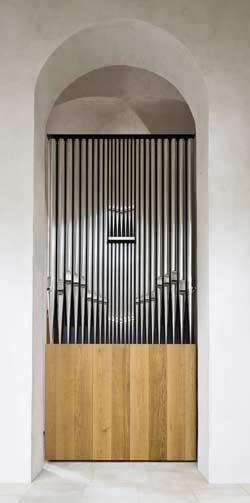
Despite its small size, the pedal possesses all the tones necessary for successfully accompanying a choir (incl. a full length, 16’ reed).
- The main section has been reduced to the essentials, however it can certainly be used to accompany the congregation for small masses (e.g. weekday services), via a 2’ and a mix.
- The swell box contains the full range of tones necessary for providing a colourful and authentic choral accompaniment, as well as for major symphonic works. When played in conjunction with the main organ, this organ can also be used as a variety of “antiphonal” for the music of the German Romantic period, thanks to its string tones.
In order to be able to make the best use of both organs, there are now also two virtually identical consoles – one attached to the main organ, the other a mobile one in the nave – from which both organs can be played. This ensures that the maximum benefit can be obtained from the options offered by both organs in Hildesheim Cathedral.


